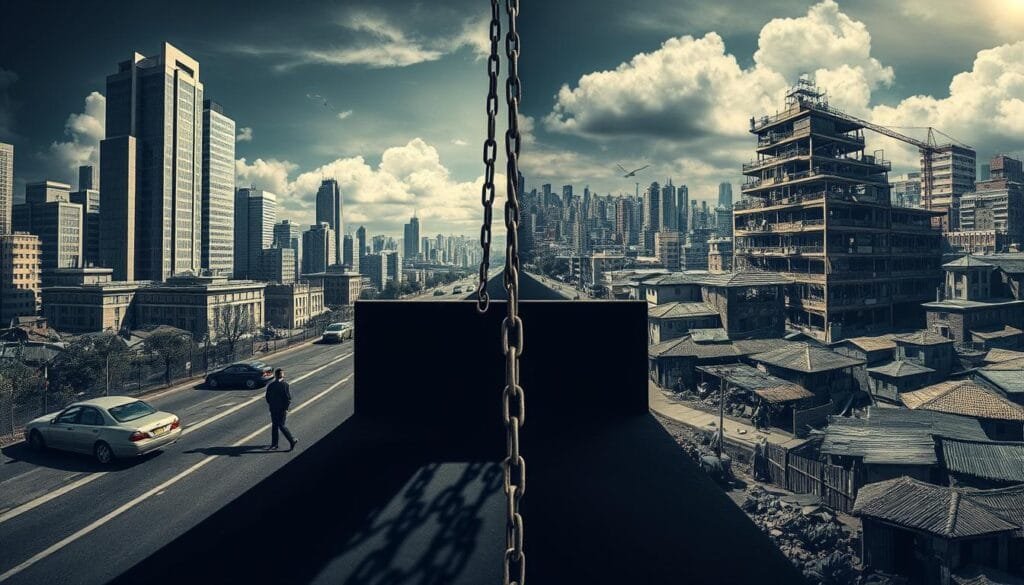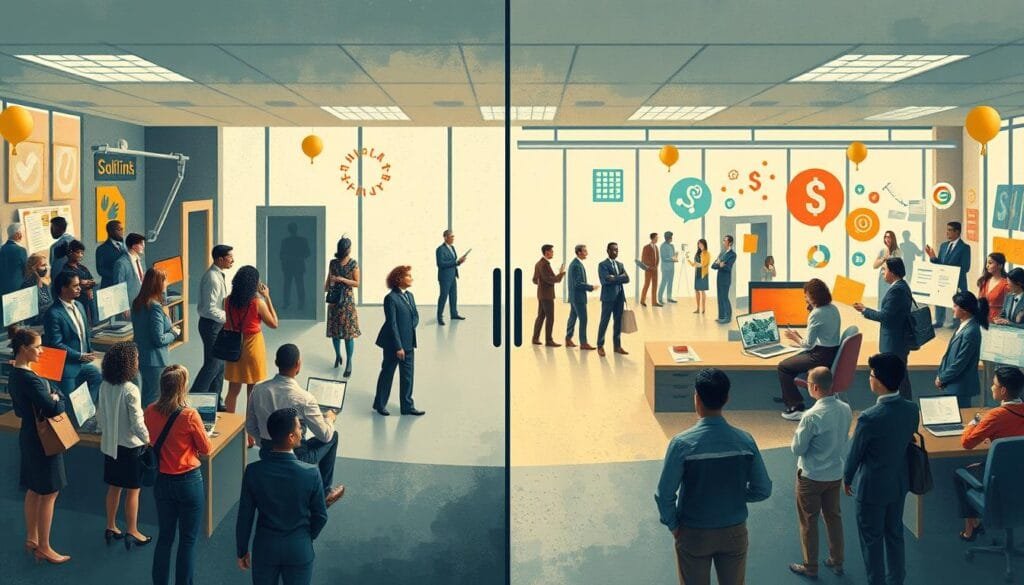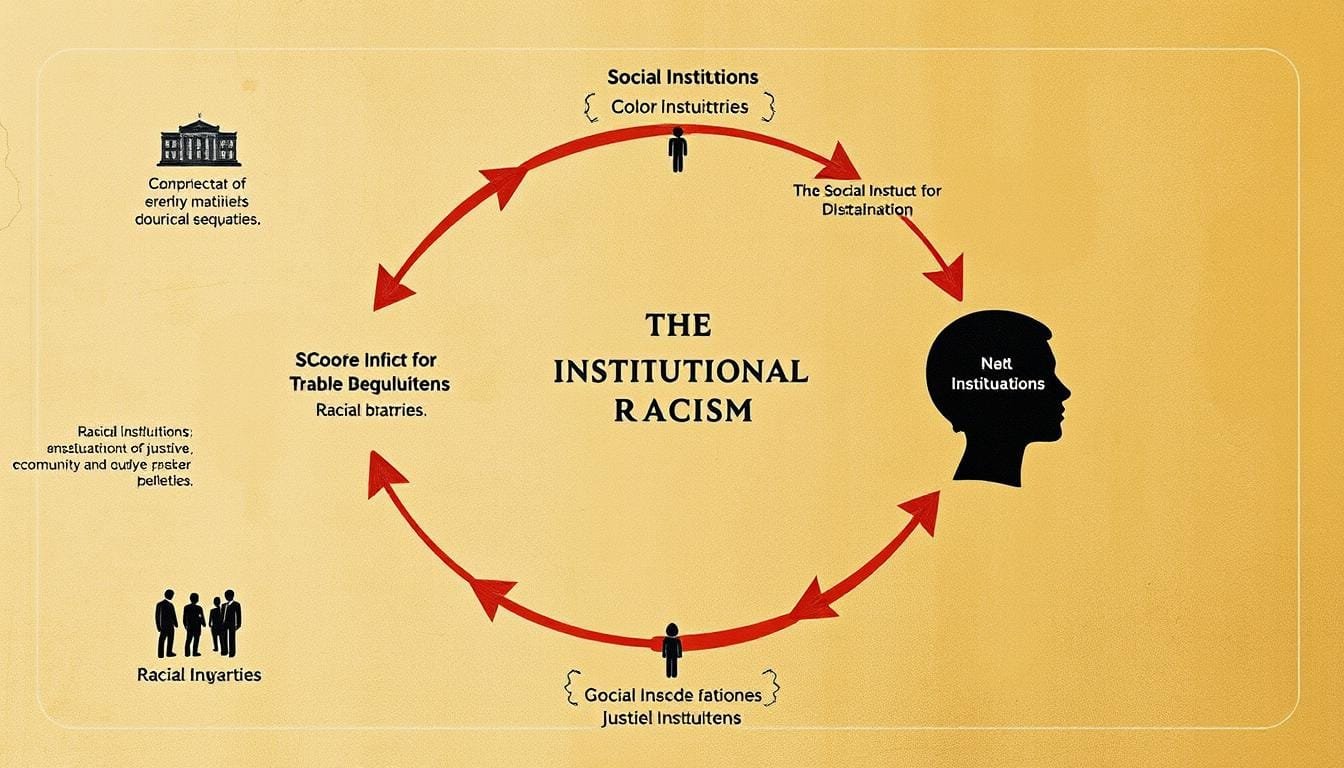We need to tackle deep-rooted institutional racism and economic discrimination to build a fair society. These issues weaken our communities by causing big gaps in wealth and opportunity. By using critical race theory, we aim to understand and fix these long-standing barriers.
Institutional racism isn’t just about obvious acts of discrimination. It’s also hidden in our laws, policies, and economics, hurting Black Americans and other minorities. It’s time to fight these systems of inequality. Breaking down these racial barriers is crucial for real progress.
We must focus on economic discrimination that comes from historical oppression. This results in huge gaps in education, jobs, and health care. The difference in wealth between races shows how deep these problems go. It’s our job to make things right and ensure everyone can succeed.
Key Takeaways
- Institutional racism goes beyond personal bias to deep, historical obstacles.
- Economic discrimination is closely linked to institutional racism, affecting wealth, education, and job chances.
- We need many strategies to solve systemic discrimination and structural racism.
- Understanding critical race theory helps us see and fix racial disparities.
- Laws like the Civil Rights Act of 1964 show how we can fight these injustices.
- Racial discrimination’s economic effects are a big problem for our country’s prosperity and efficiency.
Exploring the Roots of Institutional Racism
To grasp the historical oppression of Black Americans, we must look back. We start at slavery and Jim Crow segregation. These laid the groundwork for systemic racial discrimination. They also started the social and economic issues we see today. Understanding these roots helps us see how inequality is still a big problem.
The Historical Context of Racism and Discrimination
The history of the U.S. is deeply scarred by slavery and segregation. These targeted Black Americans. They created a lasting echo of inequality. Sociologists like W.E.B. Du Bois observed this early on. He noted how these issues keep perpetuating over time.
Defining Institutional Racism in the Modern World
Institutional racism today might not be as visible as during the Jim Crow era. Yet, it remains in our core institutions. Take hiring and loan practices. These often disadvantage Black and Hispanic people. This plays a big role in the talk about racial discrimination and social inequality. This issue is explored further in a discussion on institutional racism’s impact on minority health.
Nowadays, inequality may not always come from clear bad policies. More often, it’s from the unfair application of neutral-looking rules. We see this in voting issues, unfair political maps, or in the police treating minorities, especially Black people, very harshly. These actions remind us that institutional racism is still with us.
| Year | Event | Impact on Social Inequality |
|---|---|---|
| 1865-1877 | Reconstruction Era | Temporary gains reversed by Black Codes and Jim Crow Laws |
| 1964 | Civil Rights Act | Legal end to segregation but issues persist |
| 2023 | Continued studies on institutional racism | Shows gaps in health, education, and jobs |
Learning more about historical and modern institutional racism deepens our insight. It shows us both the barriers built over centuries and ways to overcome them. We must keep fighting these old injustices affecting millions. It’s critical to tackle these deep issues of racial discrimination and social inequality. Only then can we reach true equality.
How Can Institutional Racism Tie In With Economic Discrimination
Institutional racism and economic discrimination are closely linked. They deeply affect society in many ways. Understanding this complex relationship is key to addressing socioeconomic disparities. By looking at how these issues tie in together, we see how systemic the problems are. They affect everything from education to job opportunities.
The term institutional racism was first defined in 1967. It describes racism that is built into the policies of societal institutions. It leads to unequal access to goods, services, and opportunities, often based on race. This kind of discrimination can cause economical discrimination. Racial and ethnic minorities may face barriers that limit their economic possibilities and outcomes.
An example of how these issues intersect is evident in both history and today. Let’s look at education and economic resources. There’s a big gap in wealth and education opportunities between Black families with enslaved ancestors and those with free ancestors before the Civil War. These gaps show how deep the racial wealth divide goes.
| Background | Predicted Annual Income (2023) | College Degree Probability Increase |
|---|---|---|
| Enslaved Ancestry | $12,500 less | – |
| Free Ancestry | Baseline | 40% (Rosenwald school access) |
This table clearly shows how past institutional policies shape current economic realities. Black men with better education, like those from Rosenwald schools, tend to reach higher education levels. This improves their economic status and helps reduce the socioeconomic disparities.

In summary, institutional racism and economic discrimination are not separate issues. They are interconnected in ways that fuel ongoing inequality. By understanding and tackling these root causes, we can work to lessen the lasting impacts of these disparities.
The Impact of Systemic Racism on Employment and Income Levels
Systemic racism greatly impacts employment and income across various sectors. It’s essential to see how it influences job market inequality and income differences among racial groups. By understanding this, we can address the economic challenges they face.
Job market inequality hits different races unfairly, widening the racial pay gap over time. For instance, Black and Hispanic Americans often find it harder to get jobs than white people with the same skills. This situation shows a clear need for change.

Racial Disparities in the Job Market
Unemployment rates highlight this unfairness, with Black workers twice as likely to be jobless as white workers. Even with similar education and experience, 6.1% of Black workers are unemployed, compared to 3.0% of white workers. This bias limits job chances and economic growth for many.
Wage Gaps Between Races and Ethnicities
The wage gap is shocking. In 2019, Black workers earned 26.5% less per hour than white workers. Over 40 years, this gap has grown, showing ongoing employment discrimination. Worse, Black women face a 33.7% wage gap compared to white men, highlighting racial and gender pay differences.
Understanding the Multi-layer Impact
These issues lead to more than just lost wages. They result in higher poverty rates among Black and Latino kids. With 39% of African-American and 33% of Latino children living in poverty, systemic racism affects not just now but future generations. It prevents them from reaching their full economic potential.
Looking at these effects, it’s clear. We need policies and actions to fix racial pay gaps and job market biases. This will help create fair economic opportunities for all Americans. It’s an urgent and important task.
Education and Institutional Racism: Barriers to Economic Equality
Exploring how racism in education influences economic inequality is crucial. Educational gaps are more than just academic issues. They’re part of bigger systemic problems linked to economic equality. It shows why solving these issues is important.
Schools in neighborhoods with primarily Black or Hispanic folks often don’t have needed resources. This leads to underfunded schools and overcrowded classes, unlike schools in richer, mainly white, areas. Such educational disparities hurt students’ future job chances and keep poverty going.

Even after Brown v. Board of Education, schools still deal with segregation. This keeps educational resources unfairly spread out. This makes educational disparities worse and breaks promises of racial and economic equality.
The impact of educational barriers shows in big differences in success among racial groups. Black and Latinx students often graduate less and struggle more to get into college than White students. These issues highlight ongoing racism in education and its big effect on economic chances over a lifetime.
Tackling these deep-rooted barriers is key for real economic equality. We must face the complex impact of institutional racism in education. And we must fight for fair reforms that give all students the chances they deserve.
To fix these problems, we need more than policy changes. We all must work to see and stop the deep prejudices that block educational and economic success for many in underrepresented communities.
The Role of Housing and Wealth Accumulation in Widening Economic Disparities
Housing policies have deep roots in economic inequality. They are shaped by a history of unfair practices. Today, this shows up as housing discrimination and differences in who owns homes. It also relates to problems in gathering wealth.
The dream of home ownership connects to building generational wealth. Yet, racial differences have made this hard for many. Practices like redlining have denied mortgages to mainly non-white communities. This has harmed their chance to build wealth over time.
Redlining and Its Long-Lasting Effects on Wealth
Redlining started in the 1930s and suppressed economic growth for non-white people. Banks would not lend money or provide services based on race, not credit history. This lowered property values in these areas, blocking wealth building for many living there.
Home Ownership and Racial Wealth Gaps
Homeownership rates vary widely by race. Recent data shows a big gap between Black and White families owning homes. Also, homes in Black neighborhoods are valued lower than in White areas. This means a huge loss in equity.
Most property appraisers are White. This creates a risk of lower valuations in minority areas, making wealth gaps worse. Despite changes in laws, the legacy and current practices still mirror redlining’s effects.
We need to know this to address the problem. Safe housing is key to building wealth. Yet, racial issues from the past and today make this hard to achieve for many.
Health Inequities: A Product of Economic Discrimination and Racism
When we look into health inequities, the link to economic discrimination and racism is clear. These factors greatly affect many people’s health. The way these issues interact and impact health is complex.
The effects of racism on health are undeniable. People facing racial discrimination often have worse health. This is due to the stressful environments created by such injustices.
Residential segregation groups poverty and pollution in certain areas. This affects schools, jobs, and healthcare, making health issues worse in these communities.
Looking at infant mortality rates reveals deep inequalities. Black infants are much more likely to die than White infants. Likewise, certain racial groups face higher pregnancy-related death rates.
The difference in life expectancy between races also shows this inequality. For example, Black Americans generally live five years less than their White counterparts. This reflects the lasting impact of racism and economic discrimination.
Efforts to fix these health issues have been made. President Biden’s actions and the Child Tax Credit expansion are good steps. They show an understanding of how deep these problems go. Still, we must do more to end these health disparities.
It’s vital to understand how race, ethnicity, and finances play into health issues. With this knowledge, we can target and fix the root causes of health inequities caused by economic discrimination and racism.
Legislative Frameworks and Their Role in Addressing This Dual Discrimination
Legislative frameworks are key in shaping our society, especially in fighting racism and economic discrimination. The study of laws and policy impact shows a mix of setbacks and progress. Looking at how laws have changed over time helps us understand their effect on fairness.
Policies That Have Perpetuated Discrimination
History shows that some laws have pushed certain groups to the margins. For example, the unfair internment of Japanese Americans during World War II. And harsh deportation policies targeting U.S. citizens of Mexican descent have reinforced racial inequalities.
Rules like those from the Federal Housing Administration stopped Black families from getting housing loans. This has deeply affected their wealth and community strength.
Recent Moves Towards Equity and Justice
Lately, there’s been a push for laws that promote fairness. Over the past ten years, reforms have worked to tear down economic discrimination and boost justice. Updating old laws and making new ones with fairness in mind has been key.
Recent efforts show a big push for equality through new laws across different areas:
| Legislation/Initiative | Impact | Year |
|---|---|---|
| Equity Action Plans | 90 federal agencies commit to increasing accessibility to government services. | 2022 |
| Updated Equity Action Plans | Introduction of over 100 new strategies to enhance federal inclusivity. | 2023 |
| Child Tax Credit Expansion | Significant reduction in child poverty. | 2021 |
| SNAP Benefits Increase | Enhanced food security for millions. | Recent |
Not just through laws, but also in courts, we see a stronger stand for justice and equity. Every new law helps remove barriers, making fairness a reality, not just a goal.
Conclusion
As we conclude our discussion on institutional racism, it’s essential to note that almost half of Americans see racism as a major issue. About 49% of Americans are aware of the severe problems caused by racial discrimination. This awareness is a step forward, but not enough. Still, a significant number of Black Americans, 33%, have suffered from racial discrimination.
In our quest for equality, the fear that 45% of Black Americans have for their lives because of their race points to a deep injustice. This signals a clear issue of inequality that demands immediate action.
Calling for change is critically needed, not just a choice. A shocking 86% of Black and 68% of Hispanic Americans believe the criminal justice system is biased against them. More than half of the Black population has experienced unfair treatment in the last month, indicating a need for systemic change.
In tackling socioeconomic injustices, it’s vital to understand the economic divide. The average African American family’s net worth is just a fraction of a white family’s. Looking at homeownership and wealth, it’s clear that systemic obstacles still block the financial success of people of color.
We all have a duty to break down these barriers through fair and just policies. If 84% of Black Americans are upset by how law enforcement treats their community, we need to listen and act boldly. Our goal should be to create a society where everyone, regardless of race, has equal opportunities for success.
Despite 89% of Whites opposing reparations, 52% of Black Americans support it for historical injustices. This difference shows we have a long way to go in understanding equity. By focusing on education, wealth equality, and fixing the criminal justice system, we start repairing the damages from historical and ongoing discrimination. Our mission should be to build an inclusive future for all.
FAQ
What is Institutional Racism?
Institutional racism is a kind of discrimination woven into society’s rules and habits. It unfairly targets certain racial groups. This leads to uneven chances in wealth, health, education, and justice.
How Does Institutional Racism Differ From Other Forms of Racism?
Institutional racism is not just a personal issue; it’s built into society itself. It shows up in policies and actions, affecting many people without direct prejudice. This keeps inequality going across large groups over time.
What Is the Historical Context of Institutional Racism?
The history of institutional racism in the U.S. includes slavery, Black codes, and Jim Crow laws. These early practices laid the groundwork for today’s discrimination and inequalities faced by Black Americans and others.
How Does Economic Discrimination Intersect With Institutional Racism?
Economic discrimination means unequal pay, jobs, housing, and wealth. Institutional racism makes these issues worse by blocking opportunities for people of color. This creates bigger gaps in wealth and success.
What Impact Does Systemic Racism Have on Employment and Income Levels?
Systemic racism often stops people of color, especially Black and Hispanic folks, from getting good jobs. They might also get paid less than white people with the same skills. This creates a big gap in income.
How Do Education Barriers Relate to Institutional Racism?
Institutional racism means some neighborhoods, often where Black or Hispanic people live, have worse schools. This makes it harder for people from these areas to get good jobs. It keeps the cycle of poverty going.
In What Ways Has Redlining Affected Wealth Accumulation for People of Color?
Redlining meant banks didn’t lend money in areas they labeled as “bad,” which were usually where people of color lived. This stopped those people from buying homes and building wealth. It’s a big reason for today’s wealth gap between races.
What Are the Patterns of Home Ownership Among Different Racial Groups?
Fewer Black and Hispanic families own their homes compared to white and Asian families. Plus, homes in Black communities tend to be worth less. This makes the wealth gap even wider.
How Do Health Inequities Reflect Economic Discrimination and Institutional Racism?
Health issues and higher death rates among minorities show the damage of economic discrimination and racism. Poor healthcare, housing, and polluted environments play a big role in these health gaps.
What Role Have Legislative Frameworks Played in Addressing Institutional Racism and Economic Discrimination?
Laws and policies are key to fighting institutional racism and economic discrimination. Even though past policies have made things worse, new reforms try to make laws fairer. They aim to fix these deep inequalities.
What Are Some Examples of Policies That Have Perpetuated Discrimination?
Some policies keep discrimination alive, like racial profiling, making it hard for people to vote, giving less money to schools in minority areas, letting banks refuse loans in certain areas, and funding schools unfairly.
Have There Been Any Recent Policy Changes to Promote Equity and Justice?
Recently, we’ve seen efforts to make things fairer, like changing voter ID laws, making it easier to vote, and creating fair housing policies. These are designed to give communities of color equal chances.
